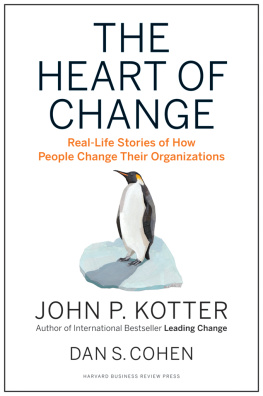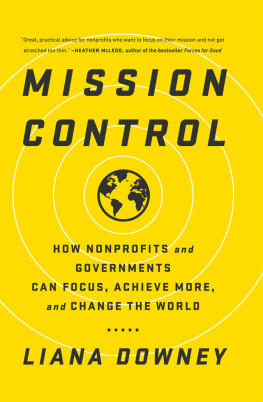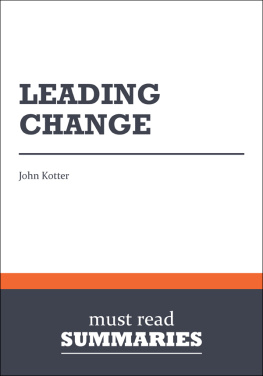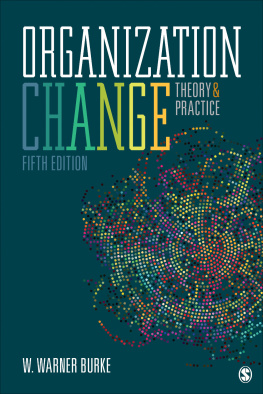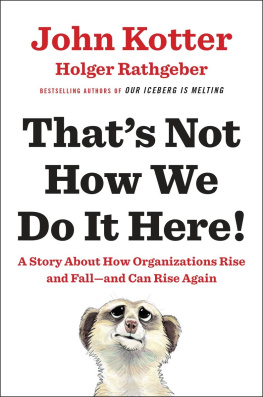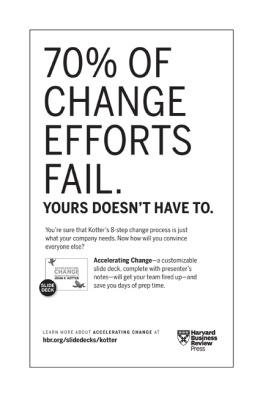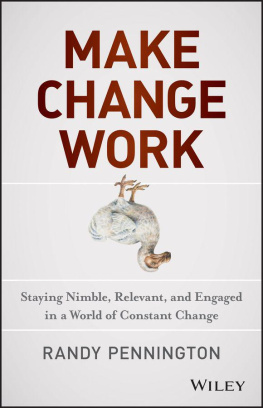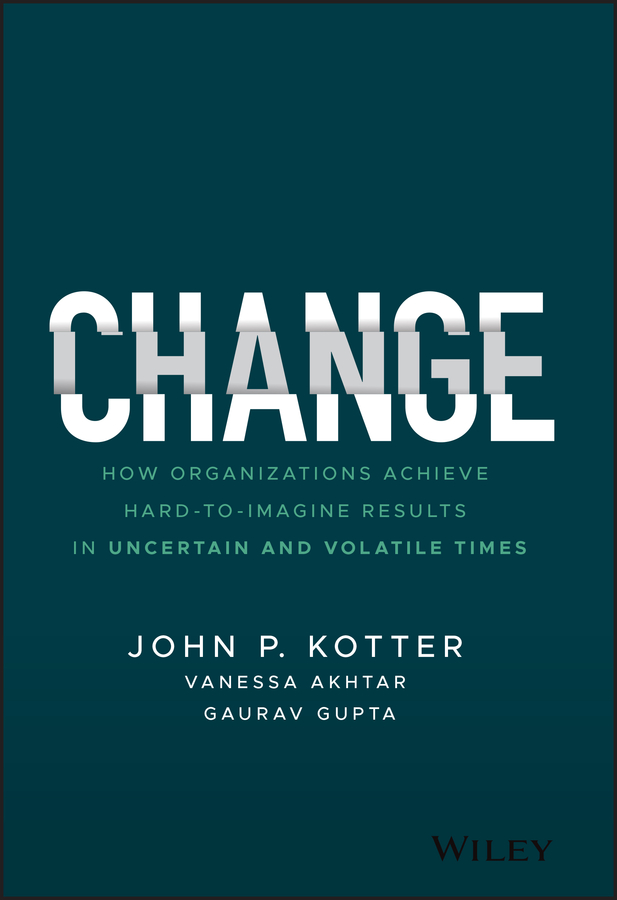
Table of Contents
Guide
Pages
Advance Praise for Change
Kotter's new book, Change, is a game changer. He and his co-authors provide deep insight into the misunderstood intersection between logical and psychological business transformation strategies. If you want your business to Survive and Thrive, this book is a must read .
Kelly S. King, Chairman and CEO, Truist Bank
This is destined to be a wake-up call for a lot of businesses and other enterprises and a classic that will be referred to for a very long time.
Extremely well written, crisp and to the point, it clearly lays out the concepts and flows seamlessly into the research/examples/cases with a compelling comparison of the old way' and the new way.' Above all, it articulates the new theories and approaches in very powerful and credible ways.
Bill Deckelman, EVP and General Counsel, DXC Technology Company
Just as they do in their consulting, the authors of this book make the complex challenge of leading change accessible . It boils down the theory of change' into commonsense advice that is actionable and relevant no matter if you are changing strategy, reconsidering structure, or simply trying to adapt at the speed of today's change. As we prepare for a post-COVID world, never has there been a time when harnessing the imagination and energy of employees has been more critical for companies that want to thrive in an environment that may look completely different than a year ago. This marvelous book can help companies prepare for this massive challengeand opportunity.
Jessica DeVlieger, Global CEO, C Space
Comprehensive. Integrated. The book helps people like myself look up from short-term pressures and keep a focus on the larger issues we face. It offers a perspective that most CEOs or chairs will immediately understand. And it is hugely relevant to the challenges we face today.
Anthony McCord, Chief Transformation Officer, New York City Mass Transit Authority
The background, history, and case studies show a new way of thinking and acting. The lessons are short, to the point, yet profound . This is a call to action for all who care to move from the ranks of management to be key leaders in their companies, industries, and communities.
Douglas Williams, EVP, COO, HMS Holdings
Different from other books on change, the focus is on three broad sets of critical influencing factors: human behavior hardwiring (to survive and/or thrive), modern organizational structures and how they undercut change, and the notion that leadership can come from everywhere and not just the top. It beautifully captures how almost everyone approaches change today, i.e., top down and metrics driven, as well as a research- and experience-based (vastly better) alternative. The dual system' idea is clever and greatly needed because we must have both the reliability, efficiency, and scale afforded by modern organizational structures and the adaptability, agility, and flexibility afforded by fluid networks.
Peter Kim, Vice President, Thermo Fisher Scientific
Change is everywhere now, yet there is no broadly accepted and effective way to adapt to it. Obstacles slow progress, and the most relevant obstacle to change and innovation is often the very nature of established firms.
Kotter and his co-authors show in this book how to build a platform able to promote and welcome change. They describe with story after story how to multiply the resources engaged in providing strategic agility, speed, and the like while continuing to deliver ongoing short-term results. They also illuminate how to make your organization ready for the next big set of changes, whatever they are.
Revealing. Intriguing. Masterful .
Alberto Irace, former CEO of ACEA, Rome Italy
The Survive/Thrive model is an extremely interesting construct, nicely illustrated throughout the entire book. Between the research and the case studies, the key implications are well covered and the points are clearly made. This makes this book a very practical point of application of brain and behavioral science.
The first two chapters make an excellent short book just by themselves. Then also are extraordinary . The reflection about what social movements can learn from businesses and vice versa is intriguing and thought-provoking. And the proclamation of more leadership from more people makes the reader crave to go look for more ways to democratize leadership.
Antonio Boadas, Chief Communication Officer, Haier/GE Appliances
Powerful and timely thought leadership that fills a much-needed gap.
Charles Fleet, Chief Transformation Officer, Omnitracs
This is a great book with a ton of insight, hugely relevant everywhere today. It's even more important in technology, where if you do not change fast enough, you get run over. Think Intel. Self-cannibalization is often key to winning. You cannot strategically plan' your way to success in technology.
Despite the massive pace of events, competition, speed, increased risk, after reading this book you will be left inspiredinspired to press your own change button.
Taner Ozcelik, SVP and Group General Manager, ON Semiconductor
Change is a science and John Kotter is a master at it. As leaders, we too often act in ways that may have worked in the past but not in our current world of fast-paced change. In Change, Kotter, Akhtar, and Gupta explain some of the new science in an easy to understand way, and share their vast experience in what works and what does not when it comes to leading change and getting great business results. If you are already familiar with John Kotter's work, this will be a natural and important continuation of what you've learned. If this is the first time you are reading John Kotter, this can be the book that really makes you thrive at what you do.
Anders Vinther, author and former Chief Quality Officer, Sanofi Pasteur
In this increasingly complex world, every leader needs this guidebook to enact meaningful change and achieve results. It is another Kotter masterpiece on leadership.
Reihaneh Irani-Famili, Vice President of Business Readiness, National Grid
CHANGE
HOW ORGANIZATIONS ACHIEVE HARD-TO-IMAGINE RESULTS IN UNCERTAIN AND VOLATILE TIMES
JOHN P. KOTTER
Konosuke Matsushita Professor of Leadership, Emeritus
Harvard Business School
Co-Founder and Executive Chairman, Kotter International
VANESSA AKHTAR
GAURAV GUPTA

Copyright 2021 by Kotter International, Inc. All rights reserved.
Published by John Wiley & Sons, Inc., Hoboken, New Jersey.
Published simultaneously in Canada.
No part of this publication may be reproduced, stored in a retrieval system, or transmitted in any form or by any means, electronic, mechanical, photocopying, recording, scanning, or otherwise, except as permitted under Section 107 or 108 of the 1976 United States Copyright Act, without either the prior written permission of the Publisher, or authorization through payment of the appropriate per-copy fee to the Copyright Clearance Center, Inc., 222 Rosewood Drive, Danvers, MA 01923, (978) 750-8400, fax (978) 646-8600, or on the Web at www.copyright.com. Requests to the Publisher for permission should be addressed to the Permissions Department, John Wiley & Sons, Inc., 111 River Street, Hoboken, NJ 07030, (201) 748-6011, fax (201) 748-6008, or online at http://www.wiley.com/go/permissions.
Next page

